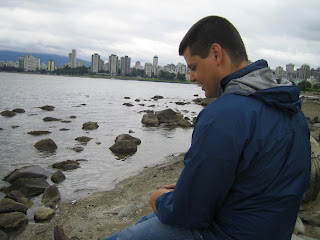These works focus on the themes of planning and community... what creates a community and what causes it to never materialize.
Radiant City talked about the in-turning of life from public to private. Homes are being built larger, cars are used as the primary (in some cases, exclusive) mode of transportation, and public life, and hence community is essentially lost. Community is now formed through groups of people going through similar experiences (kids going to school, people going to church, etc.). This has also led to an intellectual in-turning because people don't have to confront different ideas or different people or the "other". This situation has led to "suburban life" meaning more than a mode of organizing a neighbourhood, it means homogeneous.
Jacobs discusses the need for "eyes on the street" and for that to happen there has to be something interesting and/or aesthetically pleasing to look at, and as people interact with their street more, they will meet neighbours. The difficulty is that this all occurs in a very organic, unplanned way, with gradual growth. Jacobs went on to discuss how street life is essentially important to the socialization of children. As children play in these public places with a sense of community the cliche "it takes a village to raise a child" comes to life. When a child oversteps his or her bounds there is a public person - external to the family of the child to correct the error. This knowledge that everyone is watching and a certain standard of decorum is expected goes a long way in keeping people courteous and well behaved when away from parents. Jacobs goes one step further to say that this type of socialization or discipline can only be learned from an outside source, and parents will never be able to provide this lesson.
Writing this, I can see how these "eyes on the street" keeps all age groups, not just children, well behaved.
All of this also gets me thinking of my own neighbourhood. I live in Calgary Alberta on 64th avenue NW. This is the main street of the community, but it is designed as a traffic corridor. On the north side of the street there is a complex of three schools, a library, and leisure centre, a residential block, another school, then a large strip mall complex. On the south side of the street is only residential space, with a new gas station and coffee shop going in. There is also four grocery stores within a few blocks of this main street.
This street could be a main street, but instead is a traffic corridor. There are four lanes of traffic, a pedestrian overpass, chain link fence separates the traffic and acts as a pedestrian barrier. Cars routinely travel 60 + km/h on this short stretch of road and acts as a major traffic artery between deerfoot, and the NE business park and 14th street. People often take this road because the major road (McKnight Blvd.) is so busy that it pays to travel twenty or thirty blocks out of the way to detour this road.
My guess as to the traffic? the NW is mainly residential and the deerfoot corridor has a lot of industrial and office buildings, so people have to get from the NW communities along Mcknight Blvd to their work in the NE. Further, having McKnight Blvd makes it feasible to work in the NE and live in the NW, exacerbating the problem.
The net result is that I live in a community whose main street is there to ferry people from their suburban communities to their work, and results in a main street that is because of noise, high speeds and generally ugly.
I don't think it is the only reason I don't know my neighbours, but it is one reason.
Another interesting side note - I live in a condominium and the AGM was a couple weeks ago, I didn't go because of a prenatal class, and there were only five people from the building that showed up out of twenty one, and there was a note mentioning the lack of participation.
This may be because we live in a transient neighbourhood, - much like the function of our main street, people come here to leave, which makes building community seem pointless.
But often in transient neighbourhoods one year turns into five quite easily, and maybe the need to move would dissipate if that community was built?

No comments:
Post a Comment